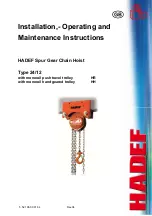
M
AINTENANCE
8.12. Check lowering limiter
WARNING
Danger from chain fracture
If the buffers are damaged, inadmissibly high
loads may act on the chain upon actuation of the
lowering limiter. The chain may break.
I
Do not use the product
I
Have the product repaired (replace buffer)
1. Move the unloaded load hook until just short
of the lower end position.
2. Stop immediately before reaching the end po-
sition and then carefully (by repeatedly press-
ing the control element) move to the end posi-
tion.
3. The movement of the chain must be stopped
due to deformation of the buffer and trigger-
ing the safety clutch. The engine will not be
turned off in the process.
4. Only have the safety clutch act for a short
time.
5. Following successful testing, the buffer must
be unloaded.
8.13. Check overload protection
WARNING
Danger due to overloading
If the overload protection is set too high, imper-
missibly high stresses may arise if a load exceed-
ing the permissible load capacity is attached.
I
Correctly set the overload protection
CAUTION
Danger from noise
By removing the silencer, the noise pressure level
of the product increases.
I
Always wear appropriate protection equipment
NOTICE
The overload protection must only be engaged
briefly in order to prevent unnecessary wear and
overheating of the drive.
The testing of the overload protection is based on
the attachment of test loads.
1. Attach 125% of load capacity. If this load is
lifted, the overload protection setting must be
corrected.
2. Attach 110%of load capacity. This load must
be lifted. A dynamic overload test of 110% of
the nominal load is therefore possible.
The overload protection is correctly set.
Correct overload protection
The adjustment
method described here is based on the attach-
ment of test loads (
,
→
Figure 14). The overload
protection is located on the gearbox.
1. Unload the hoist.
2. Detach the gearbox cover
(1)
vfrom the gear-
box in order to gain access to the threaded
pins
(2)
with lock nuts
(3)
located behind it.
3. Loosen the lock nuts. It must be ensured that
the threaded pins are not turned.
4. During each readjustment, adjust the
threaded pins to the same degree in order
to adjust the disc springs evenly:
Page
52
of 64
Doc.-No.: VA049318-20-OM-EN-0319-64-6




































